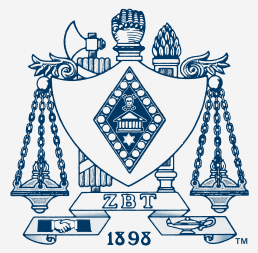Alumni & Chapter News
Alumni News
Issue: Spring 2023
By State
By Antecedent
Arizona
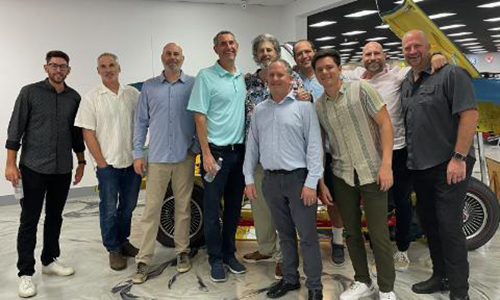 Alpha Omicron (University of Arizona)
Alpha Omicron (University of Arizona)
Jeff S. Raben, 1995, celebrated his 50th birthday with brothers, including (pictured from left): Ethan C. Weiss, 2020, Hal B. Feinberg, 1995, Thomas R. Belgrad, 1992, Daniel E. Bachus, 1992, Brother Raben, Brett M. Bernstein, 1995, Joel M. Horowitz, 1994, Reuben Z. Nach, 2020, Eric Blum, 1995, and Devin M. Sirkus, 1995.
California
Alpha Rho (University of California-Los Angeles)
Alan H. Feldstein, 1977, is the owner of Infinite Safari Adventures (www.infinitesafariadventures.com) and has been involved with the Maasai Community (pictured) in the Amboseli region of Kenya for many years. He has funded the college education of a Maasai Warrior and constructed a water well in the local community. Recently this area has been hard hit by a severe drought that was causing tragic deaths of people and native animals. Brother Feldstein jumped in and began a fundraising effort with the intent of feeding as many people as possible. To date over 1500 people have been fed due to this effort. He was recently recognized by the Area Chief of the Kenyan Interior Ministry. The idea of service learned at ZBT continues to this day.
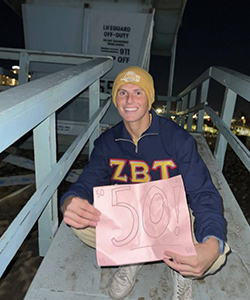
Gamma Beta (California State University-Northridge)
In December, Eric J. Bratcher, 2021, ran a 50-mile ultramarathon in the Santa Monica area to help raise money for Next Door Worldwide, which helps provide clean water to families in third world countries.
Colorado
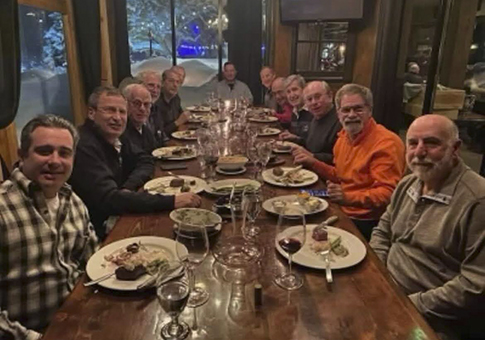 Iota (University of Denver)
Iota (University of Denver)
Brothers from the classes of 1974 through 1979 had dinner in Steamboat Springs, Colorado, in January. They are happy to continue this tradition. Brotherhood for a Lifetime!
District of Columbia
Beta Psi (American University)
The parents of the late Brother David J. Kabakow, 2015, have started a campaign to raise awareness of his rare disease. The David J. Kabakow Foundation supports research and awareness of Hemophagocytic Lymphohistiocytosis (HLH) and promotes education in the medical community. Brother Kabakow was very proud to be a Founding Father and they are asking for ZBT stories from his brothers. Details at davidjkabakowfoundation.org. The foundation is working to establish a lectureship at Mass General Brigham, a Boston-based non-profit hospital, about HLH care.
Florida
Alpha Omega (University of Miami)
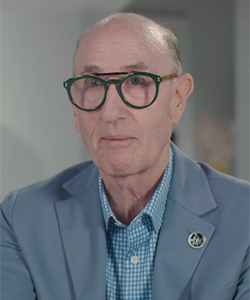 Thomas (Tommy) W. Leflein, 1973, received a Distinguished Service Award from International Home Furnishings Representatives Association at their 2022 conference. He is an Account Manager at A.R.T Home Furnishings and a District Chairman for IHFRA based in New Jersey. The IHFRA posted a video about Brother Leflein.
Thomas (Tommy) W. Leflein, 1973, received a Distinguished Service Award from International Home Furnishings Representatives Association at their 2022 conference. He is an Account Manager at A.R.T Home Furnishings and a District Chairman for IHFRA based in New Jersey. The IHFRA posted a video about Brother Leflein.
Jeffrey Jarow, 1974, moved to California in the early 1980s and never looked back. Now, he is on the Executive Board of the Santa Monica Pier Corporation, Vice President of the Southern California Sister Cities and President of the Santa Monica Sister Cities Association. Read a profile on Brother Jarow in The Santa Monica Star.
Zeta Alpha (Florida State University)
ZBT is restarting the Zeta Alpha Chapter at Florida State University in Fall 2023. We are thrilled to bring the world’s first Jewish fraternity back to Tallahassee!
If you know of any current students attending FSU or any campus who may be interested in joining ZBT, it is very helpful if you refer potential brothers. Visit zbt.org/refer to submit a student’s information. Follow the new group on Instagram @fsuzbt!
Georgia
ZBT Atlanta Area Alumni Association
The Association is resuming its local lunch series this month! These are casual, but the organizers ask brothers to please email me at zbtaaaa@gmail.com if you can attend for wait-staff planning purposes.
Monday, May 15
- 11:45am
- Miller’s Ale House, 10750 Davis Dr, Alpharetta
- Hosted by Michael W. MacLellan, Xi (Georgia Institute of Technology) 1989
Friday, May 19
- 11:45am
- Taco Mac (Prado location), 5600 Roswell Rd, F210, Sandy Springs
- Hosted by James P. Summers, Gamma Epsilon (Marshall University) 1970
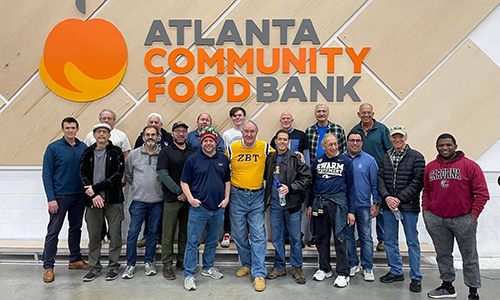 The Zeta Beta Tau Atlanta Area Alumni Association returned to the Atlanta Community Food Bank in December for an afternoon volunteer shift in the Hunger Action Center. Along with a group from Porsche Cars North America, the 20 brothers (and one son) team did very meaningful and personally rewarding work, processing 15,840 pounds of rescued product for distribution to ACFB agencies; that volume translated to 13,200 meals for food-insecure people in the community.
The Zeta Beta Tau Atlanta Area Alumni Association returned to the Atlanta Community Food Bank in December for an afternoon volunteer shift in the Hunger Action Center. Along with a group from Porsche Cars North America, the 20 brothers (and one son) team did very meaningful and personally rewarding work, processing 15,840 pounds of rescued product for distribution to ACFB agencies; that volume translated to 13,200 meals for food-insecure people in the community.
The ZBT ATL volunteer team who lived The Credo of Zeta Beta Tau and our Ritual and did this great spirit-of-giving work for the benefit of the Brotherhood of Man represented 14 alma maters and chapters from across the country.
Alphabetically, the ZBT ATL volunteer team were Robert Augustin, Zeta Alpha (Florida State University) 2017; Jeffrey Bogart, Gamma Eta (Bradley University) 1969; Brian Friedman, Psi (University of Alabama) 1992; Joe Gillette, Gamma Epsilon (Marshall University) 1973; Jonathan Goldman, Xi (MIT) 1982; Randolph Kallenberg, Psi (University of Alabama) 1997; Jay Lerner, Alpha Omicron (University of Arizona) 1986; Faron A. Lewitt, Psi (University of Alabama) 1997; Harry Lutz, Xi (Georgia Tech) 1967; Sam Lutz, Xi (Georgia Tech) 1972; Mike MacLellan, Xi (Georgia Tech) 1989; Mike’s son Ian MacLellan (Auburn); Phil Manson, Mu (University of Georgia) 1980; Bob Miller, Alpha Iota (University of Kentucky) 1968; Ken Sadeckas, Beta Upsilon (Youngstown State University) 1975; Jason Sain, Alpha Zeta (University of Florida) 1997; Sean Sullivan, Eta Lambda (Emory University) 2004; Jim Summers, Gamma Epsilon (Marshall University) 1970; Craig Varon, Xi (Georgia Tech) 1972; Alan J. Wind; Alpha Mu (University of Washington) 1981; and Lane Wolbe, Alpha Gamma (Vanderbilt University) 1966. Brothers Bogart, Friedman and Kallenberg had to leave before the group photo was taken.
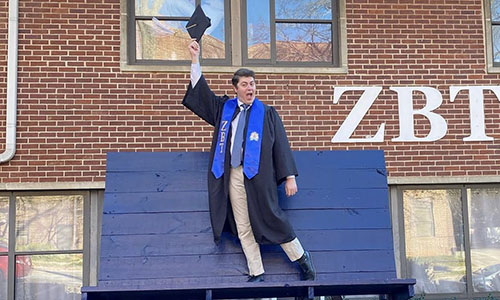 Xi (Georgia Institute of Technology)
Xi (Georgia Institute of Technology)
Gavin H. Young, 2022, graduated in December as an aerospace engineering major.
Xi Chapter has a great alumni newsletter and website with news and brother features. Check it out at gtzbt.org. Here is a recent highlight from the chapter:
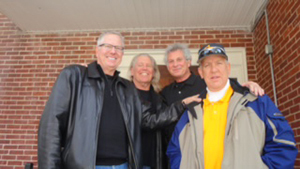 Thomas B. (Tom) Sanders, III, 1974, says that while he was in school, Zeta Beta Tau was known for the “best cook on campus.”
Thomas B. (Tom) Sanders, III, 1974, says that while he was in school, Zeta Beta Tau was known for the “best cook on campus.”
When not at the house, he and his brothers could often be found at the student center playing pool.
For Tom, the lasting legacy of ZBT is the bond of friendship that stands the test of time. “I’ve stayed in contact with a few brothers over the years and manage to see a couple who live in Florida on my road trips to see relatives/in-laws who live in the southeast Georgia area. No matter how much time passes since seeing a brother, it always feels like yesterday.”
Within four weeks after graduation, Tom got married, moved to Miami, and began a job working for the Florida Power & Light Company (FPL). He retired from FPL in 2012 and currently resides in Miami with his wife of 49 years, about one mile from their son’s family.
Illinois
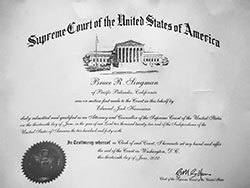 Rho (University of Illinois at Urbana-Champaign)
Rho (University of Illinois at Urbana-Champaign)
Bruce H. Singman, Esq., 1963, received a plaque upon becoming a Member of the Bar of the Supreme Court of the United States of America. He is an entertainment and securities attorney based in Pacific Palisades, California, and recently produced a movie.
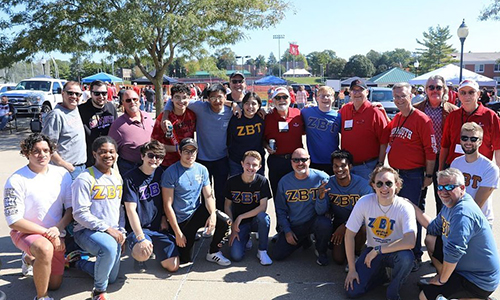 Delta Lambda (Monmouth College)
Delta Lambda (Monmouth College)
The Chapter shared that this year’s Homecoming was one to remember as Delta Lambda welcomed many alumni who came back to campus to see the Chapter continuing in good standing. Congratulations to Christopher J. Pio, 1984, on being inducted to the M Club Hall of Fame. While the Chapter did not bring the Homecoming festivities trophy this year, brothers enjoyed all events put on this year while being partnered with Kappa Kappa Gamma.
Indiana
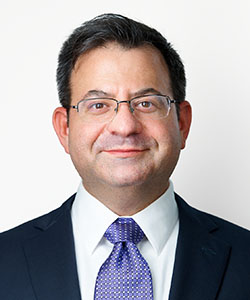 Beta Gamma (Indiana University)
Beta Gamma (Indiana University)
Evan S. Katz, 1997, started a new job as Vice President, Fixed Income Credit Analyst, at CIBC Private Wealth Management in Chicago after 25 years in various roles at Northern Trust, also in Chicago.
ZBT International Headquarters
ZBT is hiring! Working for ZBT provides you with a great opportunity to refine your professional skills, network with brothers across the country, experience new campuses and places, work with a great team, and make an impact on thousands of brothers across the world. Headquarters is based in Carmel, Indiana. See open jobs at ZBT.org/careers.
Louisiana
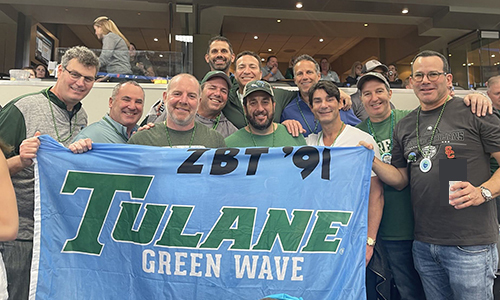 Sigma (Tulane University)
Sigma (Tulane University)
The Sigma Chapter graduating Class of 1991 cheered for the Green Wave in this year’s Cotton Bowl. Roll Wave!
Emil L. Beheshti, 1993, an actor living in Los Angeles, appeared on the television series Yellowstone for Paramount this season as “Stanley Roberts” on Season 5 Episode 4 “Horses in Heaven.”
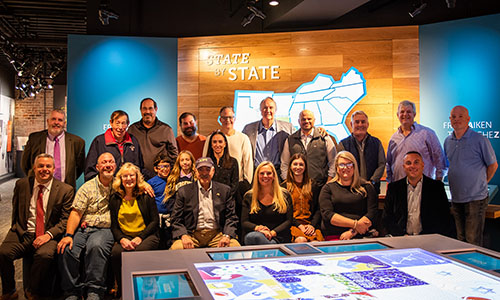 Brothers and guests attend the Museum of the Southern Jewish Experience in New Orleans. This was a trip coordinated by the Zeta Beta Tau Foundation during its most recent Board of Directors meeting.
Brothers and guests attend the Museum of the Southern Jewish Experience in New Orleans. This was a trip coordinated by the Zeta Beta Tau Foundation during its most recent Board of Directors meeting.
Massachusetts
ZBT Boston Area Alumni Association
This group had its first event in several years at The Lenox Hotel in April. About 20 brothers attended, including two Past International Presidents of the Fraternity. We look forward to many great future events in Boston. If you’d like to get involved with a future event, visit zbt.org/boston for contact information and updates.
New Jersey
Epsilon Tau (Fairleigh Dickinson University-Florham)
The West Essex YMCA has promoted James M. Butcher, 2022, to the role of competitive swim director; he will be responsible for overseeing the Y’s Racers Swim Team program, as well as the Piranhas Special Olympics Swim Team. Butcher, of West Orange, is a former Racers swim team member and has served as assistant coach, lifeguard and swim lessons instructor at the West Essex Y.
He is a recent graduate of Fairleigh Dickinson University in Florham Park, where he earned a bachelor’s degree in government and law, with a concentration in global politics and history. At FDU, he was a member of the Devils NCAA Division III swim team during his undergraduate term. He’s held leadership positions in many other college organizations, including Chapter President of Epsilon Tau. (Via Essex News Daily.)
New York
ZBT New York Area Alumni Association
Let’s go out to the ballgame! The association has secured a block of seats for the Aug. 11 N.Y. Mets game vs. Atlanta Braves. Cost is $45 ticket. Per MLB policy, tickets are only delivered digitally. ZBT will provide a digital ticket to those who register. This event is open to local New York area ZBTs as well out-of-town brothers in the City for Convention. Secure a ticket here.
We are excited to see brothers for 2023 International Convention, the kickoff celebration to ZBT’s 125th anniversary. Join us in celebrating all that is great about being a ZBT! We suggest these specific sessions where local brothers can most benefit:
Thursday, Aug. 10 at 5:45 p.m.: ZBT is hosting career- and professional development-centered mentoring receptions for undergraduates to learn from alumni in the evening. Register using the Thursday Only option to join this opportunity. No cost to attend the receptions.
Saturday, Aug. 12, all day: Start the day with great programming like the Ronald M. Mankoff Alumni Panel, and end with the Grand Awards Banquet celebrating the best of ZBT. Guests welcome. Registration is required ($350).
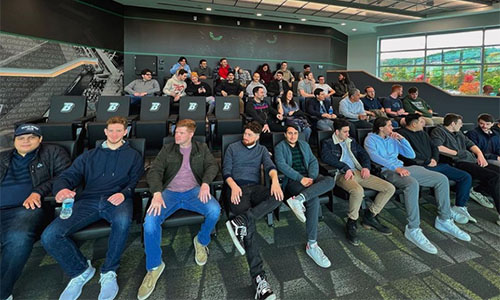 Epsilon Delta (Binghamton University)
Epsilon Delta (Binghamton University)
The first weekend in October was a local alumni reunion and meetup with the current undergraduate brothers. Brotherhood for a Lifetime!
Delta of Phi Sigma Delta (New York University)
Gilbert I. Martin, M.D., 1963, is a neonatologist and Professor of Pediatrics at Loma Linda Medical Center in Riverside California and NICU Director Emeritus at Emanate Health, Queen of the Valley Hospital in West Covina, California.
He continues to work full time and was the Editor-in-Chief of the Journal of Perinatology for many years. He is still in contact with several chapter brothers who were part of Delta Chapter from 1959-1963.
Queen of the Valley Hospital NICU just celebrated its 50th anniversary. The unit to which Dr. Martin belongs was the first neonatal intensive care facility in a community hospital in Southern California.
Omicron (Syracuse University)
Mark G. Levy, 1991, was named President and CEO and co-owner of BBX Logistics Properties, a South Florida-based logistics development firm. Brother Levy previously held senior executive positions with Prologis and Hilco Redevelopment Partners.
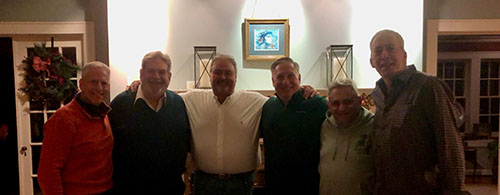 Gamma Phi (Hofstra University)
Gamma Phi (Hofstra University)
Dr. George Gardyn, 1980, and his Gamma Phi Chapter brothers from Hofstra University celebrated his 64th birthday in December. Pictured from left to right are: Ed Borenstein, 1980; Craig Wild, CPA, 1979; Dr. Gardyn; Steven Christie, 1980; Jay Sherman, 1979; and Robert Brown, 1980.
Ohio
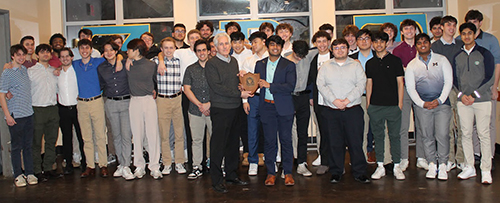 Lambda (Case Western Reserve University)
Lambda (Case Western Reserve University)
Brother Norman Friedman, Alpha Phi (Miami University) 1964, shared stories from his uncle, Brother Albie Litwak, Lambda 1939, Football Hero and War Hero (1916–1944). From Brother Friedman:
In August 2022, having discovered my uncle’s ZBT plaque among my mother’s memorabilia, I inquired whether the CWRU ZBT chapter would want the plaque to honor the memory of my uncle. That led to acquaintance with Zeta Beta Tau Foundation CEO Faron Lewitt, Psi (University of Alabama) 1997, who delighted me with his interest in the plaque and my uncle’s story.
My grandparents were among many with a similar early 1900s immigrant story, making their way from oppression in Europe to Ellis Island and on to the Midwest. Sam and Esther Litwak wound up settling in Barberton, Ohio, just outside Akron, where they raised three children: Hyman, Albert, and Ruth (my mother). Albert, who was called Obie (pronounced AH’-BEE by family and friends) soon became “Albie” in all his athletic pursuits at Barberton High, where he led the Magics as the team’s quarterback and star linebacker. A particularly notable victory was over the vaunted Massillon Lions, coached by the legendary Paul Brown, whose nationally ranked team had entered the game undefeated and unscored-upon.
At only 5’8” and hardly a speedster, Albie attracted renown because of his physical strength, leadership and intuition on both offense and defense. At one game an opposing coach thought the Barberton team was stealing signals, but Albie explained he could tell by the way one of the offensive opponents lined up what the next play was likely to be. He was often called a player-coach.
At Western Reserve University, where Saturday afternoon games often appeared on page 1 of Cleveland newspapers Sunday morning, Albie’s prowess on both sides of the ball continued. His squads lost just two games in three years––a record identical to that of his high school teams––bringing Albie recognition as Little All American among small colleges and Jewish All American.
(Coincidentally, my father’s brother, Richard Friedman, 1940, was a fellow Western Reserve ZBT and a Chapter President.)
After college Albie did some coaching, married his Akron sweetheart, with whom he had a daughter in 1943, and became an officer in the U.S. Army. He was killed in the Battle of the Bulge, in Luxembourg, on December 16, 1944, following the death one year earlier of his brother Hymie in Sicily. One journalist wrote of Albie that just as he could be counted on to rush into a void on the football field, he had done so in battle.
Among many posthumous honors, Albie Litwak was inducted into the Case Western Reserve University Hall of Fame in 1978. I attended the ceremony with my mother and have a particularly poignant memory of the evening:
It was a cold night, and as we mounted the steps to the building, a fellow bounded down to cheerily introduce himself as Ed, the person who would be speaking about Albie on stage. I was annoyed at Ed’s demeanor. Didn’t he grasp the sadness connected to this posthumous honor?
Once the cocktail hour and dinner concluded, several presenters extolled their inductees and then it was Ed’s turn, looking more serious now. He said something like this:
“You have been hearing about the exploits of tonight’s honorees on the field of play and their wonderful contributions afterward––in their work and in their communities. Albie Litwak’s life would surely have unfolded in that same way, for he was an extraordinary leader as a quarterback and on defense, guiding three teams to nearly undefeated seasons. But that was not to be for Albie because he was killed defending our country at age 28….”
My eyes got watery. “You did it, Ed,” I thought. “Sorry I underestimated you.” Then I watched my mom ascend the few steps to the podium to stoically accept the award.
Kappa of Phi Sigma Delta (Case Western Reserve University)
Ronald M. Tvert, 1959, decided to retire from his CPA firm after turning 85. He is enjoying spending time with his wife of 63 years, Meg, and his daughter Lori and grandsons.
Pennsylvania
Alpha Beta of Phi Alpha (Temple University)
Donald T. MacEwan, 1966, shared the story of his greatest professional success:
As Elscint’s National Marketing Manager, I was disappointed with Elscint’s CT sales in 1979 and early 1980. Certificate of Need (CON), which was championed by President Carter’s “there are increasingly wasteful, very expensive machines that are purchased by hospitals,” placed CT purchases into the political realm and, along with CT tractor trailers, presented significant hurdles. So, I attended CON meetings in New York, Pennsylvania, Maryland and New Jersey to get approval for Elscint’s Exel CTs. We got a few approvals, but were often overlooked for larger CT manufacturers and tractor/trailer CTs.
I believed that a single tractor/trailer CT for two or more hospitals put inpatients and ER patients at risk from delayed scans and I sought a better solution. Before leaving meetings, I asked CON committee members for a copy of their guidelines. Then, one night in my Hackensack apartment, I poured a wee bit of Glenlivet into a goblet, stacked Wes Montgomery albums on my stereo, put on my headphones, opened a pizza box then ate, drank, listened and read through the CON guidelines. I finished my first run through and had read many references to a “base service area” population criteria for CT purchases. That didn’t help. So, with “Up and At It” streaming in my ears, I poured a wee bit more Glenlivet, got a pen and underlined my United Electrical Union Vice President dad’s favorite words, share, shared or sharing within the guidelines.
Around 2 a.m., I thought, “That’s it!” and took the pen and wrote G(Gantry), G and G arched across the top of the pizza-stained napkin and a C(Computer) in the middle. Then, I drew three lines to the C from the Gs.
That morning, in my Hackensack office, I showed Elscint’s CT technical specialist, Moshe Avnet, my napkin. I explained to him that I wanted the Exel CT gantries connected over telephone lines to a shared central Exel data processing computer. I said “We’ll call it satellex.” When he replied “ein be-a-ya” (no problem), the satellex/telexel tele-radiology CT system was born. But, unlike many other tele-radiology visionaries, I was fortunate to have an exceptional CT scanner, sketched a tele-radiology CT system that arose from a deep dive into CON guidelines and Elscint’s best and brightest scientific team, led by Zami Yerushalmy.
In the autumn and winter of 1980, the prototype satellex/telexel software and hardware were tested between two Elscint Exel 905 CT installations, Perth Amboy Hospital and Paoli Memorial Hospital. Radiologists and hospital administrators were invited to see it operate. On one occasion, I demonstrated the concept. And, after that visit, I tasked our local Philadelphia representative, Kevin Lynch, to seek Ma Bell’s assistance in procuring faster communication lines.
Then, I set my sights on the city of my birth, Philadelphia, where my Phi Sigma Delta Fraternity brother and attorney, Allen J. Beckman, 1965, was a prominent political advisor. A couple months later, with the satellex/telexel three gantry price equivalent to a tractor trailer CT, my Philadelphia CON committee presentation emphasized head injuries that often require quick diagnosis of subdural hematomas. But, where is the CT tractor trailer? The Philadelphia CON approval launched the first inter-facilities digital satellex/telexel tele-radiology installation at Methodist, Graduate and St. Agnes hospitals in late spring of 1981.
Thanks to Zami’s technical group and Kevin’s resolute pursuit of Ma Bell’s high-speed communication lines, the Philadelphia satellex/telexel system worked flawlessly. It worked so well that on December 1, 1981, at the Radiology Society of North America meeting’s exhibit hall in Chicago, Graduate Hospital’s Dr. Arnold Chait was the first radiologist to use an intra-facility satellex/telexel tele-radiology remote console to view digital two-dimensional X-ray scout images, read axial images and reconstruct coronal, sagittal and oblique angles, change window levels, obtain Hounsfield numbers, communicate with his technologist and report the results more than 750 miles from his EXEL 905 CT.
Among satellex/telexel purchasers were satellite facilities of large urban hospitals, such as Philadelphia’s Albert Einstein Medical Center’s Radiology Department, chaired by an erudite Dr. Bernard Ostrum, linked to an EXEL 905 CT at Albert Einstein Medical Center’s Southern Division and small distant rural hospitals, such as, Farmington Community Hospital, in Farmington, Missouri, linked to Deaconess Hospital, St Louis, Missouri.
At that time, I was too busy with sales and installations to fully grasp the significance of what was accomplished. For with its central image storage capability (tape drive, hard drives and floppy discs) and remote telexel tele-radiology console’s backup floppy disc image storage, satellex/telexel was the true genesis of radiology’s inter-facilities and intra-facility Picture Archiving and Communication Systems (PACS).
Because of satellex/telexel’s success, I anticipated the demise of X-ray film and profitably sold Elscint’s west coast X-ray film and solution business in 1985.
In retrospect, Temple University science labs and lectures gave me knowledge but, the many late hour “bull” sessions with my Phi Sigma Delta brothers shaped my critical thinking.
Now, I’ve reached the age of needing what I sowed decades ago. I recently had a CT scan. And, after I paid my co-pay, I was given a document with instructions on how to get my images and report online. Days later, I sat at my computer, entered the portal, reviewed the images, read the report and realized that what I had scribbled on a pizza-stained napkin in 1980 is now routine, even for patients.
Tennessee
Alpha Gamma (Vanderbilt University)
Richard S. Lee, 1966, has been retired since 2011. He lives in a beautiful retirement community in Broward County. Florida. He has eight grandchildren, three of whom live with daughter and family just three miles away. He enjoys photography as a hobby.
Alpha Nu (University of Tennessee – Knoxville)
Charles Neidorff, DDS, 1969, makes note that this spring will be 54 years since graduation. He recently went back to see a football game which stirred up a lot of memories. He would like to know if anybody from the chapter is around to spearhead a reunion! ZBT International Headquarters can put others in touch with Brother Neidorff; call 317-334-1898 or email communication@zbtnational.org.
Gamma Mu (University of Memphis)
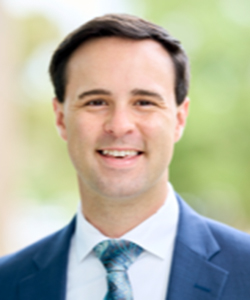 Zeta Beta Tau Fraternity is pleased to welcome Ricky E. Kirby, M.Ed, 2016, into the new role of Chief Experience Officer at ZBT International Headquarters. He earned a master’s degree from the University of Georgia in higher education administration and had several jobs on campus at UGA. Since earning his master’s, Brother Kirby has worked at several universities in leadership roles within areas such as student affairs, residence life and Fraternity and Sorority Life. Most recently, for ZBT, he has served as Chapter Advisor to Gamma Mu, a role that allowed him to serve as a liaison to the Supreme Council. As he joins the ZBT team, Ricky will continue to be based in Memphis while he completes his work on a Doctor of Philosophy in Higher Education Administration from UGA. Read more at ZBT.org.
Zeta Beta Tau Fraternity is pleased to welcome Ricky E. Kirby, M.Ed, 2016, into the new role of Chief Experience Officer at ZBT International Headquarters. He earned a master’s degree from the University of Georgia in higher education administration and had several jobs on campus at UGA. Since earning his master’s, Brother Kirby has worked at several universities in leadership roles within areas such as student affairs, residence life and Fraternity and Sorority Life. Most recently, for ZBT, he has served as Chapter Advisor to Gamma Mu, a role that allowed him to serve as a liaison to the Supreme Council. As he joins the ZBT team, Ricky will continue to be based in Memphis while he completes his work on a Doctor of Philosophy in Higher Education Administration from UGA. Read more at ZBT.org.
Virginia
Delta Xi (Virginia Polytechnic Institute and State University)
Bret W. Hrbek, CFP, CAP, 1996, was selected to be the Rotary District 7570 Governor for the 2025-2026 Rotary year. The district follows the Interstate 81 corridor from Winchester, Virginia, to Kingsport, Tennessee, and east to Danville and Lynchburg, Virginia.
Nick M. Martinelli, 2022, was recently elected as president of the Delta Xi Alumni Association.
Phi Sigma Delta
Delta (New York University)
Gilbert I. Martin, M.D., 1963, is a neonatologist and Professor of Pediatrics at Loma Linda Medical Center in Riverside California and NICU Director Emeritus at Emanate Health, Queen of the Valley Hospital in West Covina, California.
He continues to work full time and was the Editor-in-Chief of the Journal of Perinatology for many years. He is still in contact with several chapter brothers who were part of Delta Chapter from 1959-1963.
Queen of the Valley Hospital NICU just celebrated its 50th anniversary. The unit to which Dr. Martin belongs was the first neonatal intensive care facility in a community hospital in Southern California.
Kappa (Case Western Reserve University)
Ronald M. Tvert, 1959, decided to retire from his CPA firm after turning 85. He is enjoying spending time with his wife of 63 years, Meg, and his daughter Lori and grandsons.
Phi Alpha
Alpha Beta (Temple University)
Donald T. MacEwan, 1966, shared the story of his greatest professional success:
As Elscint’s National Marketing Manager, I was disappointed with Elscint’s CT sales in 1979 and early 1980. Certificate of Need (CON), which was championed by President Carter’s “there are increasingly wasteful, very expensive machines that are purchased by hospitals,” placed CT purchases into the political realm and, along with CT tractor trailers, presented significant hurdles. So, I attended CON meetings in New York, Pennsylvania, Maryland and New Jersey to get approval for Elscint’s Exel CTs. We got a few approvals, but were often overlooked for larger CT manufacturers and tractor/trailer CTs.
I believed that a single tractor/trailer CT for two or more hospitals put inpatients and ER patients at risk from delayed scans and I sought a better solution. Before leaving meetings, I asked CON committee members for a copy of their guidelines. Then, one night in my Hackensack apartment, I poured a wee bit of Glenlivet into a goblet, stacked Wes Montgomery albums on my stereo, put on my headphones, opened a pizza box then ate, drank, listened and read through the CON guidelines. I finished my first run through and had read many references to a “base service area” population criteria for CT purchases. That didn’t help. So, with “Up and At It” streaming in my ears, I poured a wee bit more Glenlivet, got a pen and underlined my United Electrical Union Vice President dad’s favorite words, share, shared or sharing within the guidelines.
Around 2 a.m., I thought, “That’s it!” and took the pen and wrote G(Gantry), G and G arched across the top of the pizza-stained napkin and a C(Computer) in the middle. Then, I drew three lines to the C from the Gs.
That morning, in my Hackensack office, I showed Elscint’s CT technical specialist, Moshe Avnet, my napkin. I explained to him that I wanted the Exel CT gantries connected over telephone lines to a shared central Exel data processing computer. I said “We’ll call it satellex.” When he replied “ein be-a-ya” (no problem), the satellex/telexel tele-radiology CT system was born. But, unlike many other tele-radiology visionaries, I was fortunate to have an exceptional CT scanner, sketched a tele-radiology CT system that arose from a deep dive into CON guidelines and Elscint’s best and brightest scientific team, led by Zami Yerushalmy.
In the autumn and winter of 1980, the prototype satellex/telexel software and hardware were tested between two Elscint Exel 905 CT installations, Perth Amboy Hospital and Paoli Memorial Hospital. Radiologists and hospital administrators were invited to see it operate. On one occasion, I demonstrated the concept. And, after that visit, I tasked our local Philadelphia representative, Kevin Lynch, to seek Ma Bell’s assistance in procuring faster communication lines.
Then, I set my sights on the city of my birth, Philadelphia, where my Phi Sigma Delta Fraternity brother and attorney, Allen J. Beckman, 1965, was a prominent political advisor. A couple months later, with the satellex/telexel three gantry price equivalent to a tractor trailer CT, my Philadelphia CON committee presentation emphasized head injuries that often require quick diagnosis of subdural hematomas. But, where is the CT tractor trailer? The Philadelphia CON approval launched the first inter-facilities digital satellex/telexel tele-radiology installation at Methodist, Graduate and St. Agnes hospitals in late spring of 1981.
Thanks to Zami’s technical group and Kevin’s resolute pursuit of Ma Bell’s high-speed communication lines, the Philadelphia satellex/telexel system worked flawlessly. It worked so well that on December 1, 1981, at the Radiology Society of North America meeting’s exhibit hall in Chicago, Graduate Hospital’s Dr. Arnold Chait was the first radiologist to use an intra-facility satellex/telexel tele-radiology remote console to view digital two-dimensional X-ray scout images, read axial images and reconstruct coronal, sagittal and oblique angles, change window levels, obtain Hounsfield numbers, communicate with his technologist and report the results more than 750 miles from his EXEL 905 CT.
Among satellex/telexel purchasers were satellite facilities of large urban hospitals, such as Philadelphia’s Albert Einstein Medical Center’s Radiology Department, chaired by an erudite Dr. Bernard Ostrum, linked to an EXEL 905 CT at Albert Einstein Medical Center’s Southern Division and small distant rural hospitals, such as, Farmington Community Hospital, in Farmington, Missouri, linked to Deaconess Hospital, St Louis, Missouri.
At that time, I was too busy with sales and installations to fully grasp the significance of what was accomplished. For with its central image storage capability (tape drive, hard drives and floppy discs) and remote telexel tele-radiology console’s backup floppy disc image storage, satellex/telexel was the true genesis of radiology’s inter-facilities and intra-facility Picture Archiving and Communication Systems (PACS).
Because of satellex/telexel’s success, I anticipated the demise of X-ray film and profitably sold Elscint’s west coast X-ray film and solution business in 1985.
In retrospect, Temple University science labs and lectures gave me knowledge but, the many late hour “bull” sessions with my Phi Sigma Delta brothers shaped my critical thinking.
Now, I’ve reached the age of needing what I sowed decades ago. I recently had a CT scan. And, after I paid my co-pay, I was given a document with instructions on how to get my images and report online. Days later, I sat at my computer, entered the portal, reviewed the images, read the report and realized that what I had scribbled on a pizza-stained napkin in 1980 is now routine, even for patients.
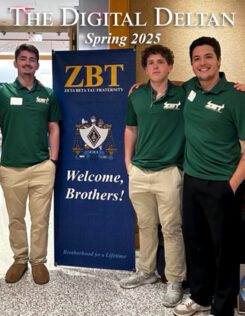 Spring 2025
Spring 2025 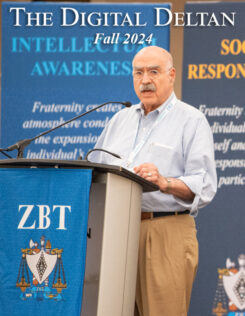 Fall 2024
Fall 2024 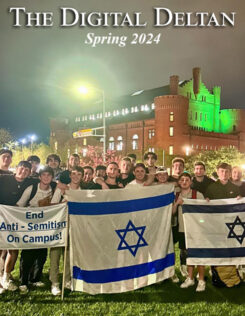 Spring 2024
Spring 2024 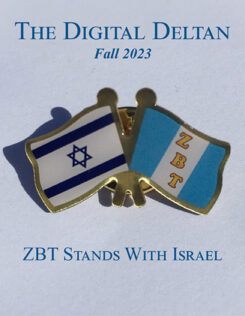 Fall 2023
Fall 2023 